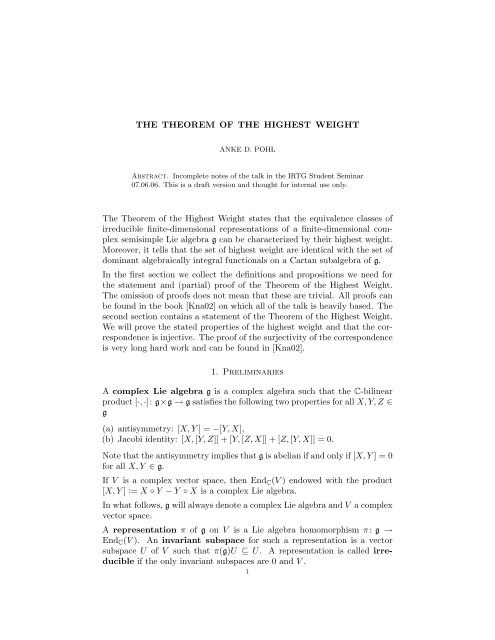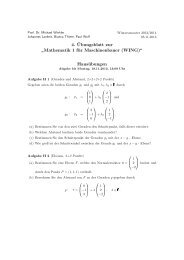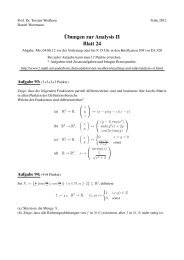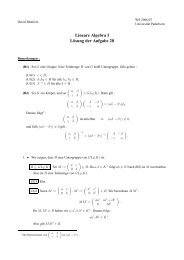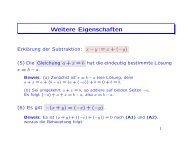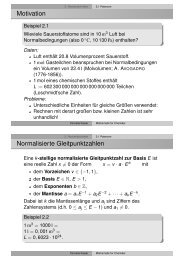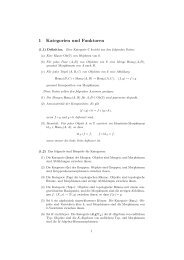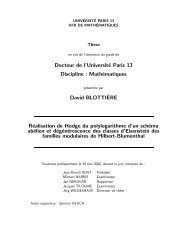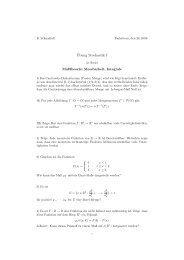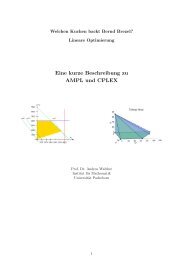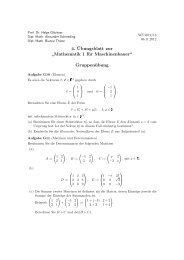THE THEOREM OF THE HIGHEST WEIGHT The Theorem of the ...
THE THEOREM OF THE HIGHEST WEIGHT The Theorem of the ...
THE THEOREM OF THE HIGHEST WEIGHT The Theorem of the ...
You also want an ePaper? Increase the reach of your titles
YUMPU automatically turns print PDFs into web optimized ePapers that Google loves.
<strong>THE</strong> <strong>THE</strong>OREM <strong>OF</strong> <strong>THE</strong> <strong>HIGHEST</strong> <strong>WEIGHT</strong><br />
ANKE D. POHL<br />
Abstract. Incomplete notes <strong>of</strong> <strong>the</strong> talk in <strong>the</strong> IRTG Student Seminar<br />
07.06.06. This is a draft version and thought for internal use only.<br />
<strong>The</strong> <strong>The</strong>orem <strong>of</strong> <strong>the</strong> Highest Weight states that <strong>the</strong> equivalence classes <strong>of</strong><br />
irreducible finite-dimensional representations <strong>of</strong> a finite-dimensional complex<br />
semisimple Lie algebra g can be characterized by <strong>the</strong>ir highest weight.<br />
Moreover, it tells that <strong>the</strong> set <strong>of</strong> highest weight are identical with <strong>the</strong> set <strong>of</strong><br />
dominant algebraically integral functionals on a Cartan subalgebra <strong>of</strong> g.<br />
In <strong>the</strong> first section we collect <strong>the</strong> definitions and propositions we need for<br />
<strong>the</strong> statement and (partial) pro<strong>of</strong> <strong>of</strong> <strong>the</strong> <strong>The</strong>orem <strong>of</strong> <strong>the</strong> Highest Weight.<br />
<strong>The</strong> omission <strong>of</strong> pro<strong>of</strong>s does not mean that <strong>the</strong>se are trivial. All pro<strong>of</strong>s can<br />
be found in <strong>the</strong> book [Kna02] on which all <strong>of</strong> <strong>the</strong> talk is heavily based. <strong>The</strong><br />
second section contains a statement <strong>of</strong> <strong>the</strong> <strong>The</strong>orem <strong>of</strong> <strong>the</strong> Highest Weight.<br />
We will prove <strong>the</strong> stated properties <strong>of</strong> <strong>the</strong> highest weight and that <strong>the</strong> correspondence<br />
is injective. <strong>The</strong> pro<strong>of</strong> <strong>of</strong> <strong>the</strong> surjectivity <strong>of</strong> <strong>the</strong> correspondence<br />
is very long hard work and can be found in [Kna02].<br />
1. Preliminaries<br />
A complex Lie algebra g is a complex algebra such that <strong>the</strong> C-bilinear<br />
product [·, ·]: g×g → g satisfies <strong>the</strong> following two properties for all X, Y, Z ∈<br />
g<br />
(a) antisymmetry: [X, Y ] = −[Y, X],<br />
(b) Jacobi identity: [X, [Y, Z]] + [Y, [Z, X]] + [Z, [Y, X]] = 0.<br />
Note that <strong>the</strong> antisymmetry implies that g is abelian if and only if [X, Y ] = 0<br />
for all X, Y ∈ g.<br />
If V is a complex vector space, <strong>the</strong>n End C (V ) endowed with <strong>the</strong> product<br />
[X, Y ] := X ◦ Y − Y ◦ X is a complex Lie algebra.<br />
In what follows, g will always denote a complex Lie algebra and V a complex<br />
vector space.<br />
A representation π <strong>of</strong> g on V is a Lie algebra homomorphism π : g →<br />
End C (V ). An invariant subspace for such a representation is a vector<br />
subspace U <strong>of</strong> V such that π(g)U ⊆ U. A representation is called irreducible<br />
if <strong>the</strong> only invariant subspaces are 0 and V .<br />
1
2 A. POHL<br />
Let π be a representation <strong>of</strong> g on V , and π ′ a representation <strong>of</strong> g on V ′ .<br />
<strong>The</strong>n π and π ′ are called equivalent if <strong>the</strong>re is a vector space isomorphism<br />
E : V → V ′ such that E ◦ π(X) = π ′ (X) ◦ E for all X ∈ g.<br />
<strong>The</strong> equivalence classes <strong>of</strong> irreducible finite-dimensional representations <strong>of</strong><br />
g are denoted by ĝ fin .<br />
We need to define three subclasses <strong>of</strong> Lie algebras: <strong>the</strong> solvable, <strong>the</strong> semisimple<br />
and <strong>the</strong> nilpotent ones. If a and b are subsets <strong>of</strong> g, <strong>the</strong>n<br />
[a, b] := 〈{[X, Y ] | X ∈ a, Y ∈ b}〉<br />
denotes <strong>the</strong> Lie subalgebra <strong>of</strong> g spanned by <strong>the</strong> elements [X, Y ].<br />
For n ∈ N we define g 0 := g and g n+1 := [g n , g n ]. <strong>The</strong> commutator series<br />
<strong>of</strong> g is <strong>the</strong> series<br />
g 0 ⊇ g 1 ⊇ g 2 ⊇ . . . .<br />
If <strong>the</strong>re is an n ∈ N 0 such that g n = 0, <strong>the</strong>n g is called solvable.<br />
<strong>The</strong> radical rad g is <strong>the</strong> largest solvable ideal in g, its existence can be<br />
proved for each Lie algebra g (cf. [Kna02, Prop 1.12]). Finally, g is called<br />
semisimple, if g has no nonzero solvable ideals, that is to say, rad g = 0.<br />
Next we define for n ∈ N <strong>the</strong> ideals g 0 := g and g n+1 := [g, g n ]. <strong>The</strong> series<br />
g 0 ⊇ g 1 ⊇ g 2 ⊇ . . .<br />
is called <strong>the</strong> lower central series for g. If <strong>the</strong>re is an n ∈ N 0 such that<br />
g n = 0, <strong>the</strong>n g is called nilpotent.<br />
Recall that <strong>the</strong> (infinitesimal) adjoint representation ad g : g → End C (g) is a<br />
representation <strong>of</strong> g on itself.<br />
Proposition 1.1 ([Kna02, Prop 2.5]). Let g be a finite-dimensional complex<br />
Lie algebra and h a nilpotent Lie subalgebra. For α ∈ h ∗ = L(h, C) define<br />
<strong>The</strong>n we have<br />
g α := {X ∈ g | ∀ H ∈ h ∃ n ∈ N: (ad g H − α(H)1) n X = 0}.<br />
(a) g = ⊕ α∈h ∗ g α , (b) h ⊆ g 0 , (c) [g α , g β ] ⊆ g α+β .<br />
If g α ≠ 0, <strong>the</strong>n g α is called a generalized weight space <strong>of</strong> g relative<br />
to ad g h. <strong>The</strong> item (c) shows that g 0 is a subalgebra. A nilpotent Lie<br />
subalgebra h <strong>of</strong> g is called a Cartan subalgebra if h = g 0 .<br />
Of special importance is <strong>the</strong> next proposition. In general, for an infinitedimensional<br />
or real Lie algebra a Cartan subalgebra does not exist.<br />
Proposition 1.2 ([Kna02, Thm 2.9, Thm 2.15]). Any finite-dimensional<br />
complex Lie algebra g has a Cartan subalgebra, and this is unique up to<br />
(inner) automorphism.
<strong>THE</strong>OREM <strong>OF</strong> <strong>THE</strong> <strong>HIGHEST</strong> <strong>WEIGHT</strong> 3<br />
If h is a Cartan subalgebra <strong>of</strong> g, <strong>the</strong>n <strong>the</strong> generalized weight spaces <strong>of</strong> Proposition<br />
1.1 are called root spaces, <strong>the</strong> nonzero weights are called roots, and<br />
∆ = ∆(g, h) denotes <strong>the</strong> (finite) set <strong>of</strong> roots. <strong>The</strong> decomposition<br />
g = h ⊕ ⊕ α∈∆<br />
g α<br />
is known as <strong>the</strong> root-space decomposition <strong>of</strong> g with respect to h. Elements<br />
<strong>of</strong> g α are called root vectors for <strong>the</strong> root α.<br />
If g is semisimple, <strong>the</strong>n a Cartan subalgebra has special properties and <strong>the</strong><br />
root spaces have a simple form.<br />
Proposition 1.3 ([Kna02, Prop 2.10, Prop 2.13, Cor 2.23, Prop 2.21]). Let<br />
g be a complex semisimple Lie algebra and h a Cartan subalgebra. <strong>The</strong>n h is<br />
abelian and ad g (h) is simultaneously diagonable. For each α ∈ ∆, <strong>the</strong> root<br />
space g α is one-dimensional and<br />
g α = {X ∈ g | ∀ H ∈ h: ad(H)X = α(H)X}.<br />
From now on let g be a complex semisimple finite-dimensional Lie algebra<br />
and h a Cartan subalgebra. Let π be a representation <strong>of</strong> g on V . For<br />
λ ∈ h ∗ = L(h, C) (complex linear functionals) we put<br />
V λ := {v ∈ V | ∀ H ∈ h ∃ n ∈ N: (π(H) − λ(H)1) n v = 0}.<br />
If V λ ≠ 0, <strong>the</strong>n V λ is called a generalized weight space, <strong>the</strong> elements <strong>of</strong><br />
V λ are called generalized weight vectors, and λ is a weight.<br />
<strong>The</strong> weight space belonging to a weight λ is<br />
{v ∈ V | ∀H ∈ h: π(H)v = λ(H)v},<br />
which is obviously a subspace <strong>of</strong> V λ . Elements <strong>of</strong> <strong>the</strong> weight space are called<br />
weight vectors.<br />
For X, Y ∈ g we define B(X, Y ) := Tr(ad X ◦ ad Y ). <strong>The</strong>n B is a symmetric<br />
bilinear form on g which is called <strong>the</strong> Killing form. It has a couple <strong>of</strong><br />
properties <strong>of</strong> which <strong>the</strong> following is important for us.<br />
Proposition 1.4 ([Kna02, Prop 2.17]). B| h×h is nondegenerate. <strong>The</strong>refore<br />
to each element α ∈ h ∗ corresponds a unique H α ∈ h such that<br />
α(H) = B(H, H α ) for all H ∈ h.<br />
<strong>The</strong> Killing form B allows to define a dual bilinear form on h ∗ via<br />
〈ϕ, ψ〉 := B(H ϕ , H ψ ) for ϕ, ψ ∈ h ∗ .<br />
A real Lie algebra g 0 is said to be a real form <strong>of</strong> g if<br />
g = g 0 ⊕ ig 0<br />
as real vector spaces. <strong>The</strong> next proposition tells us how to construct a real<br />
Lie algebra h 0 that is a real form <strong>of</strong> h such that h ∗ 0 = L(h 0, R) (real linear
4 A. POHL<br />
functionals) is <strong>the</strong> real form <strong>of</strong> h ∗ on which all <strong>the</strong> roots are real valued. <strong>The</strong><br />
pro<strong>of</strong> uses special properties <strong>of</strong> <strong>the</strong> Killing form.<br />
Proposition 1.5 ([Kna02, Cor 2.38]). Let W be <strong>the</strong> R linear span <strong>of</strong> ∆ in<br />
h ∗ . <strong>The</strong>n W is a real form <strong>of</strong> <strong>the</strong> vector space h ∗ , and <strong>the</strong> restriction <strong>of</strong> <strong>the</strong><br />
bilinear form 〈·|·〉 to W × W is a positive-definite inner product. Moreover,<br />
if h 0 denotes <strong>the</strong> R linear span <strong>of</strong> all H α for α ∈ ∆, <strong>the</strong>n h 0 is a real form<br />
<strong>of</strong> <strong>the</strong> vector space h, <strong>the</strong> members <strong>of</strong> W are exactly those linear functionals<br />
that are real on h 0 , and restriction <strong>of</strong> <strong>the</strong> operation <strong>of</strong> those linear functionals<br />
from h to h 0 is an R isomorphism <strong>of</strong> W onto h ∗ 0 .<br />
Note that <strong>the</strong> previous proposition shows that <strong>the</strong> Killing form is positive<br />
definite on h 0 .<br />
Three notions are absolutely important in <strong>the</strong> <strong>The</strong>orem <strong>of</strong> Highest Weight.<br />
<strong>The</strong> first is, <strong>of</strong> course, “highest weight” which is defined via a total ordering<br />
on h ∗ 0 . <strong>The</strong> second is “algebraically integral functional”, and <strong>the</strong> third<br />
is “dominant functional”. In fact, <strong>the</strong> <strong>The</strong>orem <strong>of</strong> Highest Weight states<br />
(among more important things) that <strong>the</strong> highest weight is an algebraically<br />
integral dominant weight, and viceversa that every algebraically integral<br />
dominant weight occurs as a highest weight.<br />
An element λ <strong>of</strong> h ∗ is called algebraically integral if 2〈λ, α〉/|α| 2 is an<br />
integer for each α ∈ ∆.<br />
Total ordering on h ∗ 0 : <strong>The</strong> aim is to define a subset <strong>of</strong> h∗ 0 to be <strong>the</strong> set <strong>of</strong><br />
positive elements such that <strong>the</strong> notion <strong>of</strong> positivity on h ∗ 0 meets <strong>the</strong> following<br />
two properties:<br />
(P1) For each nonzero ϕ ∈ h ∗ 0 , exactly one <strong>of</strong> ϕ and −ϕ is positive,<br />
(P2) <strong>the</strong> sum <strong>of</strong> positive elements is positive, and any positive multiple <strong>of</strong><br />
a positive element is positive.<br />
<strong>The</strong>n we define that ϕ > ψ or ψ < ϕ if ϕ − ψ is positive. This way a total<br />
ordering <strong>of</strong> h ∗ 0 is established. If α ∈ h∗ 0 is a root, it is called simple if α > 0<br />
and if α does not decompose as α = β 1 + β 2 where β 1 , β 2 are both positive<br />
roots. <strong>The</strong> set <strong>of</strong> positive roots is denoted ∆ + , and <strong>the</strong> subset <strong>of</strong> simple<br />
roots is denoted Π. An element λ <strong>of</strong> h ∗ is called dominant if 〈λ, α〉 ≥ 0 for<br />
all α ∈ ∆ + .<br />
One way to define such a notion <strong>of</strong> positivity is via a lexicographic ordering.<br />
One fixes a finite spanning set H 1 , . . . , H m <strong>of</strong> h 0 as (real) vector<br />
space, e.g. a basis, and endows it with a total ordering, here 1, . . . , m. <strong>The</strong>n<br />
one defines ϕ ∈ h ∗ 0 to be positive if <strong>the</strong>re exists a k ∈ {1, . . . , m} such that<br />
ϕ(H i ) = 0 for 1 ≤ i ≤ k − 1 and ϕ(H k ) > 0.<br />
Proposition 1.8 states that each weight can be regarded as an element <strong>of</strong><br />
h ∗ 0 . <strong>The</strong> largest weight w.r.t. to <strong>the</strong> introduced ordering <strong>of</strong> h∗ 0 is called <strong>the</strong><br />
highest weight. Hence, a priori, <strong>the</strong> notion <strong>of</strong> “highest weight” heavily<br />
depends on <strong>the</strong> ordering.
<strong>THE</strong>OREM <strong>OF</strong> <strong>THE</strong> <strong>HIGHEST</strong> <strong>WEIGHT</strong> 5<br />
Proposition 1.6 ([Kna02, Prop 2.49]). If l = dim R h ∗ 0 , <strong>the</strong>n <strong>the</strong>re are l<br />
simple roots α 1 , . . . , α l , and <strong>the</strong>y are linearly independent. If β is a root and<br />
is written as β = x 1 α 1 + · · · + x l α l , <strong>the</strong>n all <strong>the</strong> x j have <strong>the</strong> same sign (0 is<br />
considered to be positive or negative, as needed), and all <strong>the</strong> x j are integers.<br />
<strong>The</strong> pro<strong>of</strong> that each highest weight is dominant is based on <strong>the</strong> fact that g<br />
is spanned by embedded copies <strong>of</strong> sl(2, C).<br />
<strong>The</strong> Lie algebra sl(2, C) is generated by <strong>the</strong> vector space basis<br />
( ) ( ) ( )<br />
1 0<br />
0 1<br />
0 0<br />
h = , e = , f =<br />
0 −1 0 0<br />
1 0<br />
as a Lie subalgebra <strong>of</strong> <strong>the</strong> Lie algebra End C (C 2 ). <strong>The</strong> bracket relations are<br />
[h, e] = 2e, [h, f] = −2f, [e, f] = h.<br />
Let α be a root and let H α ∈ h be <strong>the</strong> vector defined in Proposition 1.4.<br />
Select nonzero elements E α ∈ g α and E −α ∈ g −α . <strong>The</strong>n [Kna02, Cor 2.25]<br />
states that <strong>the</strong> pair {E α , E −α } can (and should) be normalized such that<br />
B(E α , E −α ) = 1. If we set<br />
H α ′ := 2<br />
α(H α ) H α, E α ′ := 2<br />
α(H α ) E α, E −α ′ := E −α,<br />
<strong>the</strong>n we have <strong>the</strong> bracket relations<br />
[H ′ α, E ′ α] = 2E ′ α, [H ′ α, E ′ −α] = −2E ′ −α, [E ′ α, E ′ −α] = H ′ α.<br />
Hence {H ′ α, E ′ α, E ′ −α} spans a Lie aubalgebra sl α <strong>of</strong> g isomorphic to sl(2, C).<br />
<strong>The</strong> next proposition will guarantee that each highest weight is dominant.<br />
Proposition 1.7 ([Kna02, Cor 1.72]). Let π be a complex-linear representation<br />
<strong>of</strong> sl(2, C) on a finite-dimensional complex vector space V . <strong>The</strong>n<br />
π(h) is diagonable, all its eigenvalues are integers, and <strong>the</strong> multiplicity <strong>of</strong><br />
an eigenvalue k equals <strong>the</strong> multiplicity <strong>of</strong> −k.<br />
<strong>The</strong> following proposition is crucial in <strong>the</strong> pro<strong>of</strong> <strong>of</strong> <strong>the</strong> <strong>The</strong>orem <strong>of</strong> <strong>the</strong><br />
Highest Weight.<br />
Proposition 1.8 ([Kna02, Prop 5.4]). Let h 0 be <strong>the</strong> real form <strong>of</strong> h. If π is<br />
a representation <strong>of</strong> g on <strong>the</strong> finite-dimensional complex vector space V , <strong>the</strong>n<br />
(a) π(h) acts diagonably on V , so that every generalized weight vector is a<br />
weight vector and V is <strong>the</strong> direct sum <strong>of</strong> all <strong>the</strong> weight spaces,<br />
(b) every weight is real valued on h 0 and is algebraically integral,<br />
(c) roots and weights are related by π(g α )V λ ⊆ V λ+α and π(h)V λ ⊆ V λ .<br />
<strong>The</strong> universal enveloping algebra allows to extend a representation ϕ: g →<br />
End C (V ) uniquely to a homomorphism <strong>of</strong> algebras U(g) → End C (V ). This<br />
extension is <strong>the</strong> right framework for investigations on iterated actions <strong>of</strong> g<br />
on V .
6 A. POHL<br />
Proposition 1.9 ([Kna02, Prop 3.3, Remarks 2)]). Let g be a complex Lie<br />
algebra. <strong>The</strong>re is a pair (U(g), ι) such that U(g) is an associative complex<br />
algebra with unit and ι: g → U(g) is a linear mapping satisfying<br />
ι[X, Y ] = ι(X)ι(Y ) − ι(Y )ι(X)<br />
for all X, Y ∈ g<br />
such that (U(g), ι) meets <strong>the</strong> following universal property: Whenever A is<br />
an associative complex algebra with unit and π : g → A is a linear mapping<br />
satisfying<br />
π[X, Y ] = π(X)π(Y ) − π(Y )π(X)<br />
for all X, Y ∈ g<br />
<strong>the</strong>n <strong>the</strong>re exists a unique algebra homomorphism ˜π : U(g) → A such that<br />
˜π(1) = 1 and <strong>the</strong> diagram<br />
commutes.<br />
ι<br />
<br />
g<br />
<br />
U(g)<br />
π<br />
As usual, one proves that U(g) is unique up to isomorphism and that ι is<br />
injective, <strong>the</strong>refore we will identify X and ι(X) for each X ∈ g. <strong>The</strong> algebra<br />
U(g) is called <strong>the</strong> universal enveloping algebra <strong>of</strong> g.<br />
<strong>The</strong> Poincaré-Birkh<strong>of</strong>f-Witt <strong>The</strong>orem gives a vector space basis for U(g).<br />
Proposition 1.10 (Poincaré-Birkh<strong>of</strong>f-Witt, [Kna02, Thm 3.8]). Let {X i } i∈A<br />
be a basis <strong>of</strong> g, and suppose a total ordering has been imposed on <strong>the</strong> index<br />
set A. <strong>The</strong>n <strong>the</strong> set <strong>of</strong> all monomials<br />
˜π<br />
X j 1<br />
i 1 · · · X jn<br />
i n<br />
,<br />
where i 1 < · · · < i n and all j k ≥ 0, is a basis <strong>of</strong> U(g).<br />
<strong>The</strong> following version <strong>of</strong> Schur’s Lemma is needed in <strong>the</strong> pro<strong>of</strong> that <strong>the</strong> correspondence<br />
that is stated in <strong>the</strong> <strong>The</strong>orem <strong>of</strong> <strong>the</strong> Highest Weight is injective.<br />
Proposition 1.11 (Schur’s Lemma, [Kna02, Prop 5.1]). Suppose ϕ and<br />
ϕ ′ are irreducible representations <strong>of</strong> a finite-dimensional Lie algebra g on<br />
finite-dimensional vector spaces V and V ′ , resp. If L: V → V ′ is a linear<br />
map such that ϕ ′ (X)L = Lϕ(X) for all X ∈ g, <strong>the</strong>n L is bijective or L = 0.<br />
A<br />
2. <strong>The</strong> <strong>The</strong>orem <strong>of</strong> <strong>the</strong> Highest Weight<br />
Let g be a complex semisimple Lie algebra, let h be a Cartan subalgebra, let<br />
∆ = ∆(g, h) be <strong>the</strong> set <strong>of</strong> roots, and let W (∆) be <strong>the</strong> Weyl group. Let B be<br />
<strong>the</strong> Killing form <strong>of</strong> g and let h 0 be <strong>the</strong> real form <strong>of</strong> h on which all <strong>the</strong> roots<br />
are real valued. Introduce an ordering in h ∗ 0 . Let Π denote <strong>the</strong> resulting set<br />
<strong>of</strong> simple roots, and ∆ + that one <strong>of</strong> positive roots.
<strong>THE</strong>OREM <strong>OF</strong> <strong>THE</strong> <strong>HIGHEST</strong> <strong>WEIGHT</strong> 7<br />
<strong>The</strong>orem 2.1 (<strong>The</strong>orem <strong>of</strong> <strong>the</strong> Highest Weight (algebraic), [Kna02, Thm<br />
5.5]). <strong>The</strong> map<br />
ĝ fin → {dominant algebraically integral linear functionals on h}<br />
[π] ↦→ highest weight <strong>of</strong> π<br />
is a bijective correspondence. <strong>The</strong> highest weight λ <strong>of</strong> π λ has <strong>the</strong> additional<br />
properties:<br />
(a) λ depends only on <strong>the</strong> simple system Π and not on <strong>the</strong> ordering used to<br />
define Π,<br />
(b) <strong>the</strong> weight space V λ for λ is one-dimensional,<br />
(c) each root vector E α for arbitrary α ∈ ∆ + annihilates <strong>the</strong> members <strong>of</strong><br />
V λ , and <strong>the</strong> members <strong>of</strong> V λ are <strong>the</strong> only vectors with this property,<br />
(d) every weight <strong>of</strong> π is <strong>of</strong> <strong>the</strong> form λ − ∑ l<br />
i=1 n iα i with <strong>the</strong> integers n i ≥ 0<br />
and <strong>the</strong> α i ∈ Π.<br />
References<br />
[Kna02] Anthony W. Knapp, Lie groups beyond an introduction, second ed., Progress in<br />
Ma<strong>the</strong>matics, vol. 140, Birkhäuser Boston Inc., Boston, MA, 2002.


